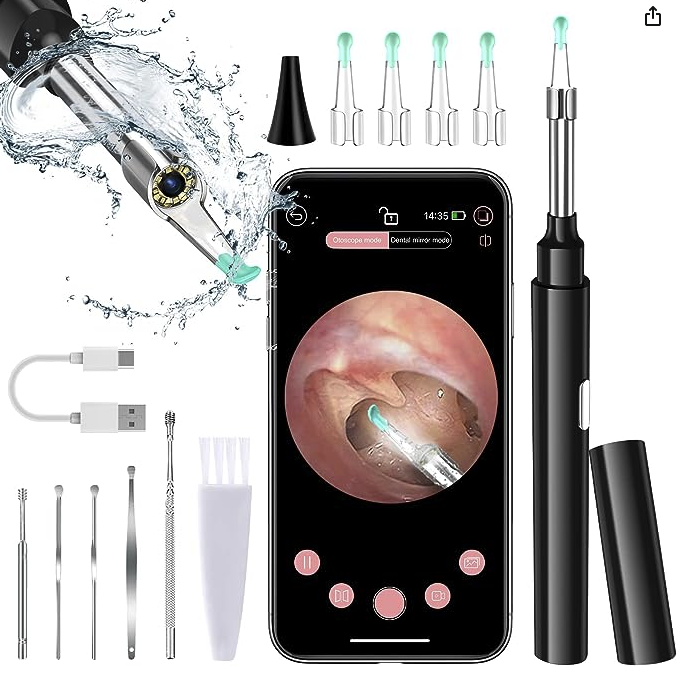Ear Cameras - A professional Audiologist's Opinion
Have you seen those viral adverts and considered buying a home use ear camera? There are plenty of budget friendly devices on the market that claim to provide a cost-effective solution to earwax removal issues. But are they safe?
What is an ear camera?
An ear wax removal camera is a small tool which is used to see inside the ear. Ear cameras available on the mainstream market are usually small, pen-like tools which often feature LED torches and the ability to stream live images or video from the ear via the user’s personal smartphone or similar device. The tool has a tip or selection of interchangeable tips which are used to dislodge and remove earwax from the ear.
Devices being advertised via viral adverts on social media are sold for as little as £9.99 on sites such as Temu, Amazon and eBay.
How does an ear camera work?
The manufacturers of these widely available ear cameras claim that their products provide safe and cost-effective ear wax removal that can be performed at home.
A popular model being sold on Amazon is marketed with an accompanying video that explains the steps to using their product: the user just needs to scan a QR code, connect the device to their phone via WiFi, and after inserting the camera, access the live feed of their ear and begin removing wax. This two minute and forty-five second video, which includes unboxing and a demonstration, makes the process sound very simple. The reviewer comments that the device is particularly handy for the reason that it can be used one handed, and used not just on yourself, but on your children or even pets.
Top selling at-home ear cameras claim that their products are safe and sterilisable, accessible and user friendly.
But are any of these claims true?
In his review of some of the most popular amateur ear cameras, ENT surgeon Vic Veer comments that not only are the devices difficult to use on yourself, but he also anticipates that using them on another person would be similarly problematic. Both usages, he suggests, would be likely to cause pain and potential damage to the ear canal.
Though some of the ear cameras on the market may be able to offer reasonable camera picture quality, the overall quality of their design, materials and functions will never match that of professional grade equipment. For example, the wallet-friendly options offered on Amazon or eBay claim detachable, food grade components. While these sound like useful attributes, the product descriptions do not acknowledge that not only are their products made with materials that, compared to professional, medically approved instruments, are inferior- but also that the average person will not be able to adequately sterilise these tools in their home.
Are ear cameras safe and what are the dangers of using them?
The dangers of using ear cameras include damage to the ear canal or ear drum, which could lead to infection, wax impaction, damage to the ear canal or ear drum. The skin of the ear canal is very sensitive and easy to damage- the thickness of the ear drum itself is only 0.1mm- and healthcare professionals agree that the ear cameras available to the public have the potential to cause lasting injury to the ears.
The risks involved in using ear cameras are vastly increased by the fact they are being operated by people without training. Although the novelty of being able to see into your ear at home is very satisfying for a lot of people- how many of those people know exactly what they’re looking at? Ear related problems, including ear wax build up, should be diagnosed by a professional who can advise the correct treatment. Even used as they are intended, at-home ear cameras are not considered to be effective in the removal of ear wax.
Are the cameras used by audiologists different to the ones you can buy in shops?
Audiologist’s cameras work on the same principle as the ear cameras available to the general public. In a professional setting, the tool used to look inside the ear is called an otoscope. Professional otoscopes are designed for use by medical professionals, who know how to operate them safely and effectively. The methods used for ear wax removal by audiologists and other health professionals differ from the limited range that cheap at-home tools offer. The ear cameras available online largely involve the manual manipulation of earwax out of the ear canal, which carries dangers of damage to the ear or eardrum, as well as compacting wax- and simply not succeeding in effective removal. Professionals are able to use safer and more effective methods of treatment, including microsuctioning and irrigation.
It is also important to note that professional equipment is tested for both performance and safety, where many of the ear cameras designed for home use are unlikely to be, or if they are, will not tested to the same rigorous standard. They are also minimally regulated in their production and clinically unevaluated in terms of their efficacy.
Should I buy an ear camera to use at home?
All evidence suggests that there are several risks associated with using an ear camera at home. Cheap ear cameras are at best ineffective, particularly when operated without specialised knowledge. At their worst, they can potentially cause serious and long-lasting injury. It is strongly recommended to seek treatment and diagnosis from a specialist.
At Ear View we offer a range of safe and effective treatments for patients seeking ear wax removal in the Suffolk area, performed by experienced audiologists. See a list of our locations and services or contact us for a consultation.


